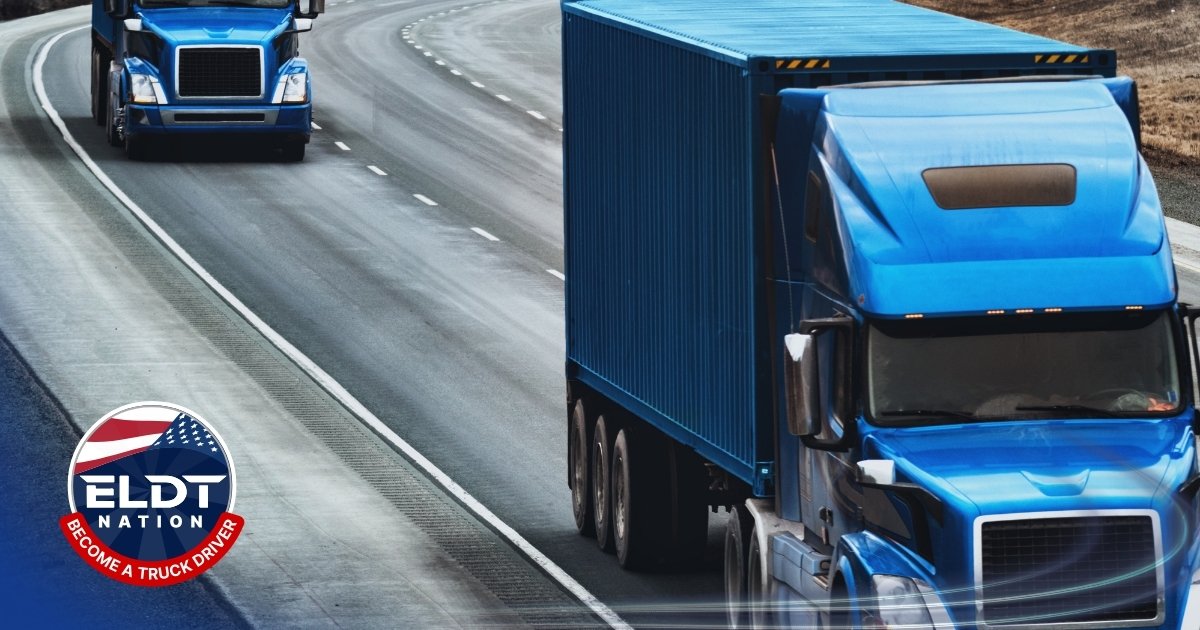What is the Average Salary of a Truck Driver in 2025? [Table]
Trucking remains the lifeline of the U.S. economy. More than 90% of all food, consumer goods, raw materials, and industrial products are transported by trucks. Without the trucking industry, store shelves would quickly go empty, construction projects would stall, and supply chains would break down. This indispensable role makes truck drivers one of the most critical workforces in the country.
As of 2025, the average truck driver salary in the United States sits at around $95,000 per year. However, this is just the middle ground. Pay varies significantly based on:
- Job type – Local, regional, or long-haul routes
- Experience level – Entry-level vs. veteran drivers
- Specialization – Hazmat, oversized loads, ice road trucking, or owner-operators
- Location – High-demand states and metro areas consistently pay more
Average Trucking Salary by Job Type [Table]
Trucking Salary Differences by State & City
The role of location in truck driver salaries
While the national average salary for truck drivers in 2025 is around $95,000 per year, the actual amount a driver earns can vary significantly depending on where they live and work. Salaries are heavily influenced by regional demand for freight, cost of living, and freight density. In high-demand markets, competition among carriers for skilled drivers pushes wages upward.
For example, drivers in urban centers and high-cost-of-living states generally receive higher compensation than those in rural areas. At the same time, certain regions with busy ports, industrial hubs, or major distribution centers are willing to pay more for timely deliveries.
Highest-paying U.S. cities in 2025
According to the latest salary data, the top-paying cities for truck drivers in 2025 include:
- Washington, DC – $120,000/year
As the nation’s capital, Washington, DC has a high cost of living and heavy demand for goods distribution. Drivers here are frequently responsible for transporting government-related freight, specialized loads, or high-priority cargo. - Phoenix, AZ – $103,000/year
Phoenix has emerged as a logistics hub in the Southwest due to its rapid population growth, proximity to California, and role as a distribution point for West Coast goods. Regional and OTR (over-the-road) drivers in Arizona often command higher rates because of freight volume and long-haul connections. - Dallas, TX – $100,000/year
Texas is a powerhouse in trucking, with Dallas serving as a central hub for cross-country freight. The state’s massive highway network and its role in oil, gas, and industrial transportation contribute to high salaries for CDL drivers. - Houston, TX – $99,000/year
As an energy capital, Houston offers strong demand for tanker and hazmat drivers in particular. Drivers in this region often haul petroleum, chemicals, and specialized industrial materials, which increases average earnings.
Regional differences explained
- Midwest: Known for its agricultural and manufacturing freight, the Midwest is particularly strong for regional hauls, which allow drivers to earn a steady income while still having regular home time.
- West Coast: States like California, Oregon, and Washington typically offer higher salaries for long-haul drivers due to high freight density and the need for specialized transport such as refrigerated goods or oversized cargo.
- South & Southwest: Growing cities like Phoenix, Dallas, and Houston provide lucrative opportunities, especially in energy and retail freight.
- East Coast: Salaries in cities like New York and Boston are high due to the cost of living and traffic congestion challenges, but job competition is strong.
In short, location matters. A driver with identical experience and endorsements can earn $20,000–$30,000 more per year simply by relocating to a high-demand city or state.
![What is the Average Salary of a Truck Driver in 2025? [Table]](https://cdn.prod.website-files.com/67d12c81bfd50e1239d7b0ff/68a84c2efc30aa87e2b5f609_What%20is%20the%20Average%20Salary%20of%20a%20Truck%20Driver_%20in%202025%20%5BTable%5D%20(1).jpg)
Experience Levels: New vs. Experienced Drivers
Entry-level drivers (0–1 year)
New CDL drivers typically start with salaries between $29,000 and $40,000 per year, translating to around $20 per hour during training. During this phase, drivers often work under probationary contracts with large carriers, sometimes earning less per mile as they build experience. Many companies also require supervised driving for the first months, which may reduce initial earnings.
Although entry-level pay is modest, the barrier to entry is low compared to other industries: drivers can enter the workforce with only a few weeks of training and no college degree.
Early career (1–3 years of experience)
Once a driver has 1–3 years of verified safe driving experience, salaries typically rise to $60,000 or more annually. Carriers value reliability and consistency, and drivers with a clean safety record can begin to negotiate better contracts. At this stage, many drivers also begin to pursue specialized endorsements such as Hazmat or Tanker, which immediately improve earning potential.
This period is often the turning point where drivers decide whether to remain as company drivers or eventually transition to more independent, higher-paying opportunities.
Experienced drivers (5+ years)
Drivers with 5 or more years of experience and endorsements frequently earn $80,000 to $100,000 per year, sometimes even more depending on region and specialization. Their extensive experience allows them to take on challenging freight, manage longer OTR routes, and secure positions with carriers that pay premium rates.
Many at this level also consider becoming owner-operators, leasing or purchasing their own trucks to take direct control over loads and rates. While this involves significant risk and business management responsibilities, it also unlocks the potential for much higher earnings.
High-income opportunities: Owner-operators and niche hauls
The most lucrative trucking roles in 2025 are found in specialized niches:
- Owner-operators: Average over $300,000 annually, with top earners surpassing $400,000. However, this comes with costs for insurance, fuel, maintenance, and compliance.
- Ice road trucking: Seasonal work but highly rewarding, with drivers earning $100,000–$120,000 in just a few months.
- Oversized loads: Pay ranges from $100,000 to $150,000 per year, reflecting the complexity and risk of hauling massive equipment or structures.
In these roles, drivers are not only operating vehicles but also running businesses, managing risk, and mastering logistics, which justifies the dramatically higher salaries.
Pay Structure in Trucking: Per Mile, Hourly, or Salary
Unlike most professions that pay strictly hourly or with a salary, trucking compensation varies depending on the type of work and the employer. Understanding the pay structure is crucial to calculating real income potential.
Pay by Mile (CPM)
The most common pay method for long-haul drivers is cents per mile (CPM). In 2025, the average pay rate is between 28 and 60 CPM, depending on the carrier and freight type.
- Example: A driver averaging 2,500 miles per week at 55 CPM earns around $1,375 weekly or $71,500 annually.
- At higher rates (60 CPM) with 3,000 miles per week, pay climbs closer to $90,000 annually.
This structure rewards productivity but can be impacted by traffic, weather, or loading delays that reduce mileage.
Hourly Pay
Some trucking jobs, especially local and fleet driving roles, pay by the hour. This method provides more predictable income but typically results in lower annual salaries compared to OTR (over-the-road) work.
- Average hourly pay: $20–$28/hour
- Annual earnings: $45,000–$60,000
Hourly pay is common for delivery drivers, regional routes, and jobs that involve warehouse duties in addition to driving.
Salary-Based Pay
A smaller portion of carriers offer set salaries for drivers, often to provide consistency and reduce turnover. Salary structures are usually tied to dedicated routes and fleet contracts.
- Average salary range: $50,000–$75,000/year
- May include overtime and performance bonuses
This structure benefits drivers who prefer stability and predictability, even if it caps earning potential compared to mileage pay.
Bonuses: Additional Income Opportunities
Beyond base pay, many trucking companies use bonuses to incentivize drivers. These can add thousands of dollars annually to a driver’s earnings.
- Sign-on bonus: Offered to attract new drivers, sometimes $5,000–$10,000 upfront.
- Mileage bonuses: Rewards for hitting monthly or yearly mileage goals.
- Fuel efficiency bonuses: Drivers who use less fuel through careful driving earn extra cash.
- Safety bonus: Given to drivers with clean safety records and zero violations.
- Referral bonus: Paid when a driver refers another qualified applicant to the company.
Real-world earnings example
A driver with a base pay of 55 CPM, covering 2,500 miles per week, may earn $71,500 annually. If they also receive a $5,000 sign-on bonus, $3,000 in safety bonuses, and $2,500 in fuel efficiency rewards, their actual annual earnings could surpass $80,000.
This shows how bonuses significantly increase the final paycheck for disciplined and efficient drivers.
How Truck Drivers Can Increase Their Salary in 2025
Not all trucking jobs are equal, and the difference between an average driver and a high-earning driver often comes down to choices, specialization, and strategy. Here are the most effective ways truck drivers can increase their salary in 2025:
Obtain CDL Endorsements
Endorsements expand the type of freight you can legally haul, opening the door to higher-paying opportunities. For example:
- Hazmat (H) Endorsement: Allows transportation of dangerous materials; one of the most lucrative endorsements.
- Tanker (N) Endorsement: Required for hauling bulk liquids like gasoline, milk, or chemicals.
- Doubles/Triples (T) Endorsement: Permits hauling multiple trailers, a skill that commands premium pay.
- Passenger (P) Endorsement: Required for driving buses, charter services, or passenger vans.
Each endorsement demonstrates added responsibility and skill, and companies are willing to pay more to drivers who hold them.
Gain Experience in OTR and Specialized Loads
Over-the-road (OTR) driving remains the backbone of high trucker salaries. Long-haul drivers who consistently log 2,500+ miles per week naturally earn more than local or regional drivers. After building experience, specializing in roles such as flatbed, refrigerated (reefer), or heavy haul can significantly boost pay.
Employers value seasoned drivers who have proven they can handle difficult hauls safely and efficiently. Over time, this reputation often leads to premium assignments with higher per-mile rates.
Transition to Owner-Operator with Financing Help
For entrepreneurial drivers, becoming an owner-operator is the path to six-figure income. While startup costs for purchasing or leasing a truck are high, many carriers and financial institutions now offer programs that help drivers make the transition with reduced upfront investment.
Owner-operators have the flexibility to:
- Choose their own loads
- Negotiate directly with shippers
- Control their schedules
- Build long-term client relationships
Though expenses cut into gross income, owner-operators retain the ability to scale their business and maximize profits in ways company drivers cannot.
Choose High-Demand States & Cities
Location matters in trucking. Drivers in Washington, DC, Phoenix, Dallas, Houston, and Chicago consistently earn more due to freight density and cost of living adjustments. Relocating to a logistics hub or working with carriers that specialize in these regions can raise annual salaries by $15,000–$25,000 compared to working in rural or low-demand areas.
Leverage Bonuses & Negotiate CPM
Smart drivers don’t just settle for base pay. They actively negotiate cents per mile (CPM) with carriers and maximize bonuses. In 2025, many companies offer:
- Sign-on bonuses ranging from $2,500 to $10,000
- Safety and performance bonuses for clean driving records
- Fuel efficiency bonuses for responsible driving habits
- Referral bonuses for bringing in new drivers
These extra earnings can push an average $70,000 salary closer to $90,000 or more. Negotiation skills, combined with consistent performance, are essential tools for maximizing income.
![What is the Average Salary of a Truck Driver in 2025? [Table]](https://cdn.prod.website-files.com/67d12c81bfd50e1239d7b0ff/68a84c3e35d54195d34e6971_What%20is%20the%20Average%20Salary%20of%20a%20Truck%20Driver_%20in%202025%20%5BTable%5D%20(2).jpg)
Start Your CDL Journey with ELDT Nation
If you’re considering a trucking career, there has never been a better time to get started. At ELDT Nation, we specialize in helping new drivers quickly and confidently earn their CDL through FMCSA-approved online training.
Why choose ELDT Nation?
- FMCSA-approved and recognized in all 50 states
- 100% online, self-paced courses — no classrooms required
- Interactive video lessons and quizzes to keep learning simple and effective
- Direct FMCSA reporting — once you pass, your results are automatically submitted
- Flexible financing options for all students
How it works
- Access our FMCSA-approved courses online.
- Pass your theory test from home at your own pace.
- Complete behind-the-wheel training with a partnered CDL school.
- Start earning serious money as a professional truck driver.
Your trucking career starts today
The average truck driver now earns nearly $95,000 annually, with endless potential for six figures. Don’t let opportunity pass you by.







